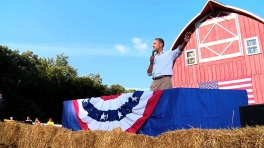Policy Initiatives
President Obama’s administration understands that a strong American economy is contingent upon a strong rural economy. Since the creation of the White House Rural Council, the President has made historic investments in rural America designed to drive job growth. The actions will help ensure the development of a rural economy built to last. These actions include:
Made in Rural America
The President directed the White House Rural Council to bring together federal resources to help rural businesses and leaders take advantage of new investment opportunities and access new customers and markets abroad. Department of Commerce Secretary Pritzker, Department of Agriculture Secretary Vilsack, Small Business Administration Administrator Contreras-Sweet, U.S. Trade Representative Froman, and Export-Import Bank Chairman Hochberg are leading forums in rural America this summer to highlight opportunities for rural manufactures, value added producers, and service providers to grow their businesses by expanding to international markets. The partnership will also host a “Made in Native America” forum this fall to help Native-owned businesses access export opportunities.
Increasing Capital Access for Rural Small Businesses
USDA and SBA committed to providing $175 million in microloans to small businesses in rural areas for Fiscal Years 2013 and 2014, in addition to new business training and counseling opportunities. To date, the two agencies have supported more than $85 million to rural small businesses.
Department of Health and Human Services Support for Rural Health Care
The Department of Health and Human Services took a number of regulatory and policy actions in 2012 to assist rural hospitals, clinics and clinicians who play a key role in ensuring access to high-quality health services in Rural America, including announcing a number of new proposals announced aimed at reducing the regulatory burden faced by rural hospitals, clinics and clinicians, among others. Read the full list of actions here.
Supporting Appalachian Communities
Facilitated through the White House Rural Council, the Appalachian Regional Commission (ARC) developed a Livable Communities Initiative. This initiative is a partnership between ARC, the U.S Environmental Protection Agency (EPA), and the U.S Department of Agriculture Rural Development (USDA RD). The initiative provides technical assistance to small rural towns to help them develop and implement strategies for making the communities more livable and competitive. The partnership will focus on expanding transportation choices, supporting thriving and distinctive rural communities by investing in rural town centers, and extending affordable housing opportunities.
Accelerating Broadband Infrastructure Deployment
On June 14, 2012, President Obama signed an Executive Order to make broadband construction along federal roadways and properties up to 90 percent cheaper and more efficient. U.S. agencies that manage federal properties and roads are partnering to offer carriers a single approach to leasing federal assets for broadband deployment. Providing a uniform approach for broadband carriers to build networks is speeding the delivery of connectivity to communities, business, and schools in rural America. In order to further expand the nation’s broadband service, more than 25 cities and 60 national research universities are partnering to form "US Ignite." US Ignite is creating a new wave of services that will extend programmable broadband networks to 100 times the speed of today's Internet. To further leverage private-sector involvement, a three-day Application Summit was conducted this June at the headquarters of Juniper Networks in Silicon Valley. This session made numerous connections that will strengthen rural and urban communities through innovative broadband applications. In total, this partnership will improve services to Americans and drive job creation, promote innovation, and create new markets for American business.
U.S. Department of Education Investing in Rural Schools
Through the national broadband plan, the Obama administration is leveraging the power of technology to overcome distance and increase collaboration to accelerate student achievement in rural schools. The White House Rural Council partnered with the U.S. Department of Education to deliver a new online community of practice groups for rural schools. This online tool is creating virtual communities of practice for educators to connect to resources, tools, colleagues, experts, and learned activities both within and beyond schools. As part of the push for broadband in public schools, the Federal Communications Commission (FCC) is investing $2 billion over the next two years to dramatically expand high-speed Internet connectivity for America's schools and libraries — connecting 20 million more students to next-generation broadband and wireless. Private-sector companies have also committed more than $2 billion to deliver cutting-edge technologies to classrooms. The Administration is using technology to break down geographic barriers and address rural isolation in education.
MOU to Improve Support in the Colonias
The U.S. Department of Agriculture-Rural Development (USDA-RD), Housing and Urban Development, and Department of Treasury’s Community Development Financial Institutions Fund (CDFI) partnered to create the Border Community Capital Initiative. This collaboration is designed to expand access to capital in the U.S/Mexico border region which includes some of the poorest communities in the country. The Memorandum of Understanding (MOU) will provide up to $200,000 to nonprofit and/or tribal financial institutions that serve colonias. This funding will go to increase access to basic necessities such as safe drinking water, adequate sewage systems, and safe, sanitary housing.
Small Business Administration Investing in Rural Small Businesses
The Administration extended more than $400 million in FY 2011 of investments in rural America through the Small Business Investment Company (SBIC) Impact Investment Program, at no cost to taxpayers. Nearly $2 billion in additional funding will be invested by the end of fiscal year 2016. These investments will continue to help finance, grow, expand, and modernize rural small business operations around the country.
Advancing Water Quality Conservation Across the U.S.
The United States Department of Agriculture (USDA) announced the launch of a new National Water Quality Initiative committed to improving one to seven impaired watersheds in every U.S. state and territory. The Initiative is part of the Obama Administration's White House Rural Council which is working in partnership with farmers, ranchers and forest owners to improve conservation of working lands in rural America. The 157 selected watersheds were identified with assistance from state agencies, key partners, and USDA's Natural Resources Conservation Service (NRCS) State Technical Committees. NRCS will make available at least $33 million in financial assistance to farmers, ranchers and forest landowners this year to implement conservation practices to help provide cleaner water for their neighbors and communities.
Promoting a Bioeconomy Through BioPreferred
To support the Administration’s “Blueprint for a Bioeconomy,” the President is utilizing the purchasing power of the federal government by directing federal agencies to take additional steps to significantly increase the purchase of biobased products over the next two years, which will create thousands of new rural jobs and drive innovation where biobased products are grown and manufactured. Utilizing the existing BioPreferred program, the federal government will use its procurement power to increase the purchasing and use of biobased products, promoting rural economic development, creating new jobs, and providing new markets for farm commodities. Biobased products include items like paints, soaps, and detergents and are developed from plants, rather than chemicals or petroleum bases. The biobased products sector marries the two most important economic engines for rural America: agriculture and manufacturing.
Rural Jobs Accelerator
The “Rural Jobs Accelerator” links federal programs to facilitate job creation and economic development in rural communities by utilizing regional development strategies. The "Rural Jobs Accelerator" allows multiple agencies to coordinate technical assistance and grant/loan programs so that a consortium of public and private rural entities can have a single access point within the federal government, creating improved access, streamlining of programs, and better leveraging of resources. USDA, EDA, Delta Regional Authority, and Appalachian Regional Commission have leveraged approximately $9 million in funding, with additional technical support from various federal agencies including the Department of Housing and Urban Development and the Department of Education.
Development of Rural Health IT Workforce
HHS and the DOL signed a memorandum of understanding to link community colleges and technical colleges that support rural communities with available materials and resources to support the training of HIT professionals. Rural health care providers face challenges in harnessing the benefits of health information technology (HIT) due to limited capital and a workforce that is not trained to work within the expanding field of HIT. Due to lower financial operating margins and limited capital, funds for hiring new staff or training existing staff in HIT implementation and maintenance are often simply not available to rural health care providers. The Bureau of Labor Statistics estimates that the needed HIT workforce will increase by 20 percent by the year 2016. A significant part of that growth will come in rural areas, which are served by approximately 2,000 rural hospitals, 3,700 Rural Health Clinics as well as the more than 3,000 Community and Migrant Health Centers that are either located in or serve rural communities.
Timber and National Forest Restoration
USDA’s Forest Service, in conjunction with the White House Rural Council, released a strategy to increase the scale of restoration treatments like forest thinning, reforestation, and other activities to restore and sustain the health of our forests. In addition to environmental benefits, these activities create jobs in the forest industry which has been hurt significantly by the economic downturn. The strategy relies on (1) using collaborative approaches to broaden public support for forest restoration; (2) expanding restoration tools like the Collaborative Forest Landscape Restoration Program and stewardship contracting; (3) better targeting budget resources; and (4) streamlining forest planning and analysis without sacrificing quality.
Mortgage Refinancing
The Administration announced an initiative to assist rural homeowners refinance their mortgages at lower interest rates through USDA’s Rural Development agency. By reallocating existing funding, at no additional cost to taxpayers, USDA will have almost doubled the amount of funds available to homeowners seeking to lower their mortgage payments or avoid foreclosure. Under the new allocation, the amount of the $24 billion program dedicated to refinancing will increase from $520 million to $1.1 billion, allowing USDA to meet the growing demand for refinance transactions.
Task Force on Tourism and Competitiveness
On January 19, the President signed an Executive Order creating a Task Force charged with developing a National Travel and Tourism Strategy with recommendations for new policies and initiatives to promote domestic and international travel opportunities throughout the United States. The strategy will include recommendations to promote visits to the United States public lands, waters, shores, monuments, and other iconic American destinations, thereby expanding job creation in the United States, as well as tourism opportunities in rural communities. The Task Force is co-chaired by Secretary Salazar and Secretary Bryson, with participation from USDA, other agencies and WH offices.
Doubling Small Business Administration (SBA) Investment Funds for Rural Small Businesses
The Administration established a rural "carve-out" in the Small Business Investment Company (SBIC) Impact Investment Program that will invest in distressed areas and emerging sectors such as clean energy. SBA will provide up to a 2:1 match to private capital raised by the fund. SBA and the U.S. Department of Agriculture (USDA) are committed to partnering to drive $350 million of investment capital through the fund and existing SBICs into rural small businesses over five years, doubling the current rate of investment.
Providing Job Search Information through USDA Field Offices
The USDA and Department of Labor (DOL) partnered to offer job training information and better utilize the rural footprint of the USDA field offices across the country to provide them with greater access to job search resources by reducing the driving times and distances for rural customers seeking program information.
Expansion of the National Health Service Corps to Critical Access Hospitals
The Department of Health and Human Services (HHS) expanded eligibility for the National Health Service Corps loan repayment program so that Critical Access Hospitals, those with 25 beds or fewer, can recruit new physicians, using student loan repayment incentives. This program will help hospitals across the country recruit needed staff. Once a hospital has qualified as a service site, it can then apply for student loan repayment on behalf of its primary care physicians, nurse practitioners, and physician assistants.
Expanding Health Information Technology in Rural Communities
USDA and HHS signed an agreement to improve access to capital for rural hospitals and other providers seeking to implement health information technology and expand the health IT workforce in rural communities.
Commercial Aviation Biofuels Partnership
The Navy, the Department of Energy, and USDA have joined forces to spur the creation of an advanced biofuels industry that will support commercial aviation, with a pledge of $510 million, over three years, under the Defense Production Act of 1950.
Read all posts tagged Rural
-
The President’s Executive Order and the US Ignite partnership are a two-pronged approach to help speed the delivery of broadband connectivity to communities, businesses, and schools across the Nation.
-
Three federal agencies announced a new project to assist high-need rural areas facing chronic poverty along the U.S.-Mexico border. This new project is part of a series of initiatives delivered through the White House Rural Council, which recently released a report detailing the historic steps President Obama and this administration have taken to support rural America.
-
The White House Rural Council announces the U.S. Department of Education's new online community of practice group for rural schools.
-
Today President Obama announced new investments to help rural small businesses expand and hire
-
This week marks the one-year anniversary of the creation of the White House Rural Council, an Administration-wide initiative to support and strengthen America’s rural economy. SBA announces efforts to ensure that entrepreneurs who live in rural areas have the access and opportunity they need to start, build, and grow their businesses.
-
NRCS Chief Dave White highlights the launch of a new National Water Quality Initiative committed to improving one to seven impaired watersheds in every U.S. state and territory.
-
In an event focused on issues around access to care and improving health outcomes in rural communities, the White House Rural Council was joined by Health and Human Services Secretary Kathleen Sebelius, Agriculture Secretary Tom Vilsack and a group of 24 rural health care providers.
-
America's nearly 400 national parks include 84 million acres of breathtaking landscapes, historical sites and cultural treasures -- and this week they are all free!
-
Lead by Chairman Harold "Gus" Frank, the Potawatomi Community proves their commitment to protecting Mother Earth and "ensuring that future generations will have access to clean air, water and land," by incorporating renewable and energy-efficient initatives into their daily lives.
-
Last year, USDA provided biomass project funding assistance for a total of 52 projects with just over $31 million in grant and loan note guarantees
- &lsaquo previous
- …
- 3
- 4
- 5
- 6
- 7
- 8
- 9
- 10
- 11
- …
- next &rsaquo



